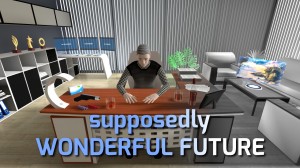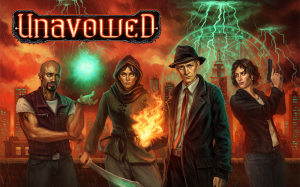Review for Solo: Islands of the Heart

At first glance, the world of Solo: Islands of the Heart looks like the perfect getaway: a house on an island surrounded by endless blue ocean, with swimming turtles and occasional cute wild animals that you can feed. Underneath the façade of this scenic vacation, though, lies a journey of self-discovery and recollections of love, as ancient totems and spirits await with questions only you can answer. The unexpected marriage between puzzle-adventure and introspective quizzes makes Solo a rare experience where you actually get to learn a bit more about yourself by the end and have fun doing it.
In Solo you play as yourself, represented by an avatar based on the gender (including non-binary) and model of your choice, as you sail away to reflect on your love life and relationships while solving puzzles from island to island, guided by the ghost of your ‘lover’ and various spirits throughout the archipelago. The main goal in each new setting is to reach a talking totem sitting on a cliff or nearby island and answer a personal question. Whether you’re freshly heartbroken, currently in love, or never had any experience with romantic relationships before, you can spill your story to the totems.
Along your island-hopping trip, you’ll notice that each new question is always related to the previous one, or even your previous answer. The totems weave a narrative out of your stories, so one player might have a different narrative chain than another, depending on the choices made. Each question touches a different subject and presents you with possible situations that may appear during a relationship – something about intimacy, career choices, family, and so on, and they are meaningful enough that with each one I always stopped and contemplated for a while. I wanted to pick the one that was closest to what has happened in my life, or at least imagine what I’d do in such a scenario.
The developers stress the importance of being as honest as possible, right from the very beginning, claiming: ‘…to get the most of the experience, we encourage you to think and answer based on your lived experiences.’ While you don’t have to do so, particularly if you wish to experience some of the other options, I chose to follow this advice. Because in the end, this journey was my journey, in a sense. I wanted to arrive at an ending that’s based on my truth and principles and not anybody else’s.
Between the quizzes, you get to relax and enjoy the islands, maybe chill out and play your guitar a little bit, take a few pretty Polaroid photos, or simply sit and enjoy the tranquil ocean view. My personal favorite leisure activity is probably the swings on the edge of the cliffs. Moving the thumbstick up and down will swing you forward and back, just like you would on a real swing with your legs!
This is one of the reasons why playing with a gamepad is highly recommended – as suggested in the loading screen – even though an option for keyboard/mouse control is also available. If you want to experiment, you can even switch between the two just by pressing a key on your keyboard or a button on your controller. But using analog sticks to maneuver around the islands definitely feels a lot more natural, as does freely adjusting the camera all around you.
You won’t want to rush, however, as it’s hard not to get lost in the serene island atmosphere. With soft strums of acoustic guitar in the background, accompanied by the calming waves of the ocean, it almost feels like time here never moves forward. It might be the neverending sunshine that washes over the land or the relaxed movements of the local creatures that made my whole adventure seem to have happened in just a single long Saturday afternoon, when in reality I actually spent more than twelve hours playing.
There’s an all-around lightness in the way the environment looks. The vividly-colored objects are stylish renderings of cubes and spheres, with round shapes seen in the humans, totems, and adorable little creatures living on the islands, while squares are evident in the shapes of the islands themselves and their buildings. This approach also translates into the flora and other island details, with tree branches that bend at right angles, and thick leaves formed by soft-edged cubes. The minimalist presence of familiar shapes makes these landscapes feel like a safe haven to clear your mind. The only danger you might have to encounter is perhaps the nostalgic memories of your own relationships.
As tranquil as it is, Solo isn’t just a walk down memory lane. Every time you step onto a new island, a number of boxes (more squares, though some of them assymetrical) magically drop from the sky, scattering around the perimeter to be picked up. These are used to reach the lighthouse on each island, which is usually located on higher ground or a nearby island separated from the main one. You can pick one up by hand or by using your magic wand to move them someplace else, stack them together to climb to higher ground, or position them in a certain way to create ‘bridges’ to cross. Each box comes with a distinct function; for example, one of them has a fan that blow you upwards, so if you climb on it you can sort of ‘glide’ on the wind. What’s cool is that you can also rotate each box both vertically and horizontally, creating even more possibilities to solve a puzzle. If you flip that fan box upside down, you’ll basically get a box hovering in the air!
The rest of the boxes include a basic wooden variety, a bridge box that expands when placed, and a suction box that sticks to walls and other boxes. Not all of them are immediately available in the beginning, as each type will show up one by one as the tale progresses. These boxes sound simple enough to utilize, but I found that crossing to another island was a real challenge that put my imagination to the test. Even after creating what I thought was a decent enough bridge, often times I still found myself falling off, either out of clumsiness or out of miscalculation. If I fell into the water, I had to swim back to my starting point and start over, which wasn’t so bad since I got to meet the turtles that way. One time I even got a clue on how to solve a puzzle by swimming around the islands and spotting an extra box that I could use.
I eventually learned that various factors such as distance, height, and the effectiveness of how you put boxes together greatly affect your chances. Meticulous as it sounds, it just needs a little bit of common sense and some trial and error to get a grasp of the situation. ‘Do I need to go higher than this?’ ‘Is my bridge too short?’ At times I felt like someone who really was stranded on an island and being pushed to try all the possibilities until I was able to succeed and activate the lighthouse. From there, a colorful beam of light would shoot to where the totem was located, thus giving me a new puzzle to solve.
The only downside of this routine is that the game doesn’t provide a manual save option. The autosave only occurs after a completed puzzle or a significant event, such as activating a lighthouse or entering a new island. So whenever I needed to quit the game, I had to finish a puzzle to trigger the next automated checkpoint if I didn’t want to lose my unsaved progress on that island.
Each island or level has a theme to introduce about relationships, such as communication or anger. This is never displayed blatantly on-screen, but you can tell by following the narrative and interacting with the ghost of your lover. What’s interesting is how the box puzzles are often designed to match the themes. For example, after I talked (well, listened, as the protagonist doesn’t speak) with my ghost lover about the importance of communication, the bridge box was introduced soon after, and most of the puzzles that followed became about creating a bridge between two islands.
Moving further through the islands, the puzzles of course become more intricate with the combination of various boxes. Some variants offer a different ‘bridging mechanism’, such as a quest to reunite two animals in love, separated by a broken bridge, or a plea to restore a dying flower garden that should bloom again if you manage to direct the water flow into the flower patches. For this particular task, there’s a different type of box that acts as a hose for the water, allowing you to bend the flow of water by rotating the box. A more mysterious type of puzzle can be found inside some of the beach buildings, which require you to match a set of boxes with their shadows.
There are also side activities you can do on the islands whenever you’re stuck on the main bridging puzzles. There are letters and music sheets to collect, which are nice little additions because you can affect the environment by playing the tunes you get from them on your guitar. One is a melody to summon rain and another turns the whole island black and white for a tinge of melancholy. I spent quite some time trying out each new melody that I acquired to see what magic I could bring to my surroundings. Even before acquiring these special abilities, I was having fun on my own, jamming on my guitar by the ocean.
Reading the questions from the totem and carefully weighing each of my answers, I couldn’t help but wonder if they were all based on real-life romances and the pain that often comes with them. Turns out the game is indeed inspired by the personal experience of Team Gotham’s creative director, and it truly shows: every written dialog, every meeting with the ghost lover contain the faint melancholy of someone who’s been through the ups and downs of relationships in a way that is universally relatable.
After solving all the puzzles and responding to all the questions that needed to be answered, my surreal journey came to a close. Without spoiling anything, let’s just say that everything makes sense in the end. It’s heartwarming to know that you’ll have choices like these to make in the future, and humbling to think that all the decisions made in the past have led you to where you are now. Maybe, after all, Solo: Islands of the Heart isn’t about going solo after parting ways with a significant other or waiting to meet the one, but rather a matter of being solo, alone for a time to take a step back from life and foster a relationship with yourself. Even if romance is not what you seek, chances are good that you’ll find yourself in love with the charms of these lovely, puzzling islands.
Review copy generously provided by GOG.com.






























